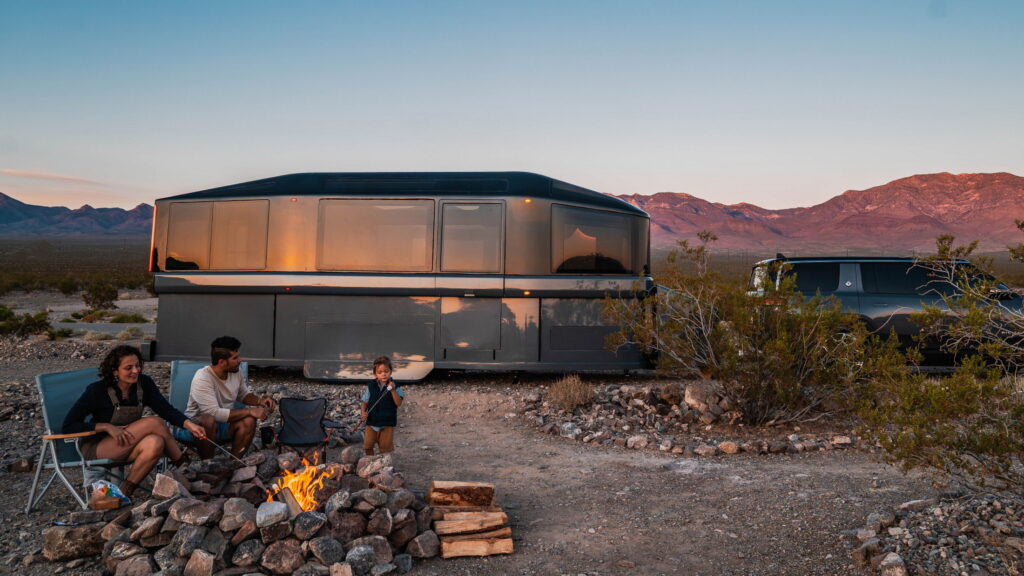This electric camping trailer claims it can be towed by an EV without impacting range
December 15, 2023 at 09:30
 –>
–> 
–>
Although range anxiety is becoming less and less of an issue, it still afflicts people who want to tow trailers. That’s why Lightship has come up with the L1, a highly aerodynamic trailer that can be equipped with electric motors to make it feel like you aren’t towing anything at all.
With the motor, the startup claims that the trailer can be towed behind an electric vehicle, such as a Rivian R1S, with almost no impact on range. However, Lightship isn’t just focused on adding motors to stuff, as it also wants to take advantage of passive efficiency to make EV camping as anxiety-free as possible.
To wit, in recent testing of a prototype L1 Essential (that is, the model without drive motors), Lightship reports that the Rivian R1T used as a tow vehicle was able to go 1.26 miles per kilowatt-hour. Naturally, that’s less than the SUV was able to manage unburdened (2.17 mi/kWh) but is 35 percent better than it was able to manage with a traditional trailer (0.93 mi/kWh).
advertisement scroll to continue
Lightyear L1 Efficiency Test (60 miles at 60 mph)
Read: Tesla Veterans Create $125K Electric Trailer That Can Be Towed Without Hurting EV Range
To put that into terms truck buyers are more familiar with, the company ran the test with a gas-powered Ford F-150. Over a 60-mile (96 km) stretch of highway (running at 60 mph) the team found that the truck was capable of achieving 23.2 MPG without a trailer, 10.2 MPG with a traditional trailer, and 14.4 MPG in a test with the Lightship L1 Essential, or 29 percent better than a conventional trailer.
That extra efficiency comes as a result of hours of aerodynamic testing. But since the company is still a relatively small startup, it couldn’t afford to just book a wind tunnel. Instead, it had to rely on simulation software developed by Angus Locke.
Locke was the lead aerodynamicist for the Tesla Roadster and now works at ENGYS, which provides 60 percent of the Formula One grid with Computational Fluid Dynamics (CFD) software. Thanks to that software, Lightship co-founder Ben Parker, another Tesla alumnus, told us in an interview, that Lightship L1’s coefficient of drag is on par with sedans like the Tesla Model 3.
That efficiency didn’t come easy, though. In addition to being wider and taller than a sedan, the team was also surprised to discover just how sensitive the aerodynamic efficiency was to vortices that occurred between the tow vehicle and the trailer.
“If you think about it, there’s lots of chaotic flow that is in the wake of the vehicle, but then that becomes the offset flow of the trailer,” said Parker. “You have to minimize those losses in that gap between the two vehicles and, as seamlessly as possible, you have to reattach the flow that’s coming off the truck to the body of the trailer.”
Thanks to the advanced CFD software, the team could spend a long time working on ways to “fill the gap” between the two vehicles, and fix the airflow. And since Lightship’s trailer doesn’t really look like any others, it has had to figure out how to do that for itself. Parker describes it as feeling like the team is doing a Ph.D. while it makes a new product.
The result of that education is a trailer that can be towed up to 300 miles behind a long-range electric truck when its electric motors are running. Meanwhile, thanks to its collapsible roof, it’s also comfortable to stand, cook, eat, and sleep in.
Set to go into production next year at an assembly facility in Colorado, the Lightship L1 Essential starts at $125,000, while the one with the motors, the L1 Long Range, starts at $151,000. While Parker admits that means it won’t be a high-volume trailer, he says that the price point was selected precisely because there is an established market for RVs that cost that much.
He adds, too, that the company has a longer-term plan that involves using technology developed on the L1 to make other products that might be more affordable. Until then, people in the market for a trailer like this one can reserve one for $500.
[embedded content]
Lightship_L1_Aerodynamics_Wind_Tunnel_Final (1) from Rob Williams on Vimeo.


